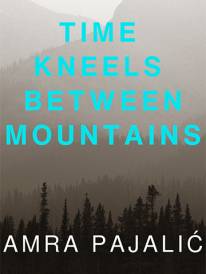Joaquin Phoenix Her
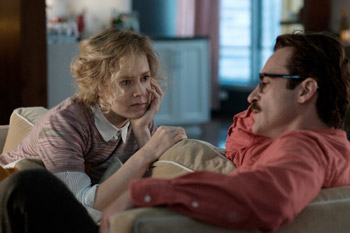
Joaquin Phoenix Her
Cast: Joaquin Phoenix, Amy Adams, Scarlett Johansson
Director: Spike Jonze
Genre: Comedy
Rated: MA15+
Running Time: 126 minutes
Synopsis: Written and directed by Spike Jonze, 'Her" is set in Los Angeles, in the near future and follows Theodore Twombly (Joaquin Phoenix), a complex, soulful man who makes his living writing touching, personal letters for other people. Heartbroken after the end of a long relationship, he becomes intrigued with a new, advanced operating system, which promises to be an intuitive and unique entity in its own right. Upon initiating it, he is delighted to meet 'Samantha," a bright, female voice (Scarlett Johansson), who is insightful, sensitive and surprisingly funny. As her needs and desires grow in tandem with his own, their friendship deepens into an eventual love for each other. 'Her" is an original love story that explores the evolving nature"and the risks"of intimacy in the modern world.
Her
Release Date: January 16th, 2014
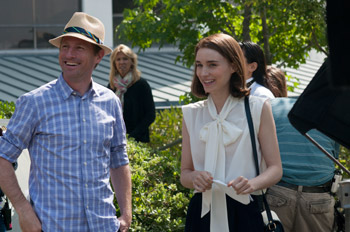 About The Film
About The Film
Writer/director Spike Jonze brings his distinct style and insight to this modern relationship story, 'Her," a film that takes an unconventional look at the nature of love.
'One of the most challenging aspects of a relationship is being truly honest and intimate and allowing the person you love to be the same," he says. 'We're changing and growing all the time, so the question is, how do you allow them the freedom to be who they are, moment to moment, day to day and year to year? Who are they going to become, and can you still love them?"
Moreover, can they still love you?
These are some of the questions and ideas that emerge when Theodore brings home a state-of-the-art, voice-controlled computer operating system…and meets Samantha.
'It's advertised as an intuitive system that listens, understands and knows you," says Spike Jonze.
A highly sophisticated artificial intelligence, Samantha is immediately warm and empathetic. She soon reveals an independent streak, a wicked sense of humour, and a knack for getting to the truth of things, as well as an increasingly rich emotional range. Upon coming into existence, she quickly progresses, as does their relationship, Spike Jonze says, 'from that of an assistant to a trusted friend and confidant, and from that to something much, much, more."
Spike Jonze co-wrote the screen adaptation of Maurice Sendak's Where the Wild Things Are with Dave Eggers and, in 2010, wrote the 30-minute short 'I'm Here," which premiered at the Sundance Film Festival, but 'Her" marks the first feature film on which he is the sole screenwriter.
That he would choose to explore the all-too-human nature of love through the bond between a man and the disembodied consciousness of his operating system (OS) is not surprising. His work has been synonymous with innovation, from his breakthrough days as a music video director and documentary filmmaker, to such creative triumphs as 'Being John Malkovich," 'Adaptation." and 'Where the Wild Things Are."
Joaquin Phoenix, who stars as Theodore, found the story 'astonishing." Though involved at the time in what would become his Oscar®-nominated performance in 'The Master," he recounts, 'Whenever we had the opportunity, Spike Jonze and I would talk about the script and about the characters, and it was great to watch it all develop."
'I trust his instincts. If he has any hesitation with something, I know it needs a deeper look," says Spike Jonze, who approached the actor a week after completing the script. 'Within the first five minutes of talking to him I thought, -I love this guy. This is who I want to be in the movie.' Joaquin brings so much heart and sincerity to the role. Even though Theodore holds so much sadness, he also has a capacity for joy and playfulness and it's a sweet contrast, all of which Joaquin brings to the performance"and more."
Designed to learn and evolve on her own, Samantha is delighted by each novel experience and always wants more. At the same time, she begins to bring out the best in Theodore. 'Although she has access to all the information in the world, she is creating every thought and response in the moment," says Scarlett Johansson, who stars as Samantha. 'She has no predetermined views. So for all her depth, there's also an innocence and openness."
As Samantha's self-awareness grows, so does Theodore's. He takes her on excursions to the city, the mountains, the beach, and into the pattern of his daily routine and, with her perspective, sees these familiar haunts as he's never seen them before. He begins to see himself differently, too, which the director cites as the hallmark of every budding romance: 'You show each other different ways to look at things, which is what falling in love and being in love hopefully is all about"being with someone whose point of view excites and inspires and challenges you, and gives you insight into yourself in a new way," he says.
Sophisticated but eminently relatable, 'Her" moves from drama and heartbreak to moments of soaring romance and reflection, to the natural comic rapport of its two leads.
Joaquin Phoenix and Scarlett Johansson, together with Spike Jonze, took on the challenge of imbuing Samantha, who is never seen on screen, with the fullness and presence she deserves. 'There are so many facets to Samantha," notes Spike Jonze. 'She has to be guileless, yet witty, smart and self-possessed, and also sexy and intriguing, while believably developing as an emotional being, and it all has to come through Scarlett Johansson's performance."
Scarlett Johansson recalls, 'It was a very fluid process. Sometimes Joaquin Phoenix and I would record together and sometimes I'd be working with Spike Jonze, but there was always a degree of spontaneity in uncovering the nuances of the character and the relationship."
'Everyone on the production was committed to making it feel intimate and real," adds Joaquin Phoenix, who noted that even the atmosphere during filming was not the usual hub of kinetic activity that can compromise an actor's focus. 'Nothing felt typical on this film, from the script to working with Scarlett Johansson, to the feeling on the set, and that made it all an amazing experience."
The idea for 'Her" had been simmering with Spike Jonze for years. 'The initial spark," he recalls, 'was an article I saw online about 10 years ago, about instant-messaging with an artificial intelligence. I linked to it and I said -Hello,' and it said -Hello.' -How are you?' -Good. How are you?' We had a little exchange and there was an initial buzz of, -Wow, I'm talking to this thing, this thing is listening to me,' and then the illusion quickly dissolved and I could tell it was parroting what it had heard before and it wasn't intelligent, it was just a clever program. But that initial buzz was exciting. Eventually I thought about the idea of a man who's having a relationship with an entity like that, but a fully formed consciousness, and what could happen, and used that as a way to imagine this love story."
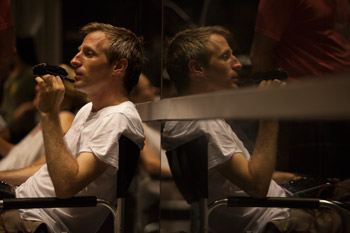 Once written, its execution quickly took on a life of its own. In addition to writing and directing, Spike Jonze also produced the film with longtime producing partner Vincent Landay and Oscar®-nominated producer Megan Ellison. Says Spike Jonze, 'Megan Ellison is very impressive. She has clear opinions and clear taste and is building a company that feels personal and intimate. She's doing something very special."
Once written, its execution quickly took on a life of its own. In addition to writing and directing, Spike Jonze also produced the film with longtime producing partner Vincent Landay and Oscar®-nominated producer Megan Ellison. Says Spike Jonze, 'Megan Ellison is very impressive. She has clear opinions and clear taste and is building a company that feels personal and intimate. She's doing something very special."
Likewise, Megan Ellison states, "Working with Spike Jonze has been a phenomenal and treasured experience. He is an extraordinarily generous and empathic filmmaker whose contributions to culture are so vast, varied, and brilliant. His ability to be playful, emotional and intellectually profound"in his work and as a person"will never cease to amaze me."
Work on 'Her" brought together the talents of Spike Jonze's numerous frequent collaborators, including production designer K.K. Barrett, editor Eric Zumbrunnen, and costume designer Casey Storm. It also marked the first time the director has worked with cinematographer Hoyte van Hoytema, of whom he says, 'What I especially liked about Hoyte van Hoytema was the sensitivity of his approach. I wanted this film to feel intimate and romantic and tactile, and he really brought a sophisticated and poetic sensibility to it.
'There are lots of ideas here about technology and the world we live in, the isolation that it can create as well as the connections it creates, and the way we're changing as a society," says Spike Jonze. 'But as I was writing the story, I always ended up putting those themes in the background. The high concept always takes a back seat to the relationship between Theodore and Samantha. Every scene is based in their reality as a couple. We wanted to look at it as a relationship between two individuals and, through them, make a story that looked at love and relationships as complexly and from as many angles as possible.
'I wanted to touch on some of the needs and fears, the judgments and expectations we bring into a relationship; the things we don't want to acknowledge, or things we pretend we don't need, but need anyway; the ways in which we connect with each other, or try to connect and fail," he continues. 'We want to be known, but at the same time, are afraid of being known.
'Samantha was created to evolve," he says. 'And once she's set in motion, like once we're all set in motion, there's no limit to where that's going to take us and who we're going to become. If you fall in love with someone, that's the risk you take."
Cast and Characters
The challenge was in presenting a love story when audiences can only see one of the two people involved. 'There was only one way it was going to work, and it was entirely dependent on Joaquin Phoenix and Scarlett Johansson. It's their performances that make the connection and the love between Theodore and Samantha something audiences can really feel," says Spike Jonze.
'To have the camera resting on Joaquin Phoenix's face and watch him listening to Samantha, and to see his love for her in his expression"to me, that was one of the most exciting aspects of the movie," the director continues. 'He's not only showing how his character feels, but he's helping to embody her through his response to her."
'We never treated it as anything other than a real relationship," adds Joaquin Phoenix.
Equally vital is the way in which Scarlett Johansson expresses Samantha's increasing self-awareness solely through a vocal characterisation that starts simply and grows to encompass a rich subtext of feeling: joy, hope, compassion, confidence, jealousy, doubt, frustration, fear.
For Scarlett Johansson, 'There was a tremendous sense of freedom in being able to create a personality without the limits or the expectations of anything physical. It was liberating."
Running concurrently to his romance with Samantha, the movie also looks at the aftermath of Theodore's marriage to Catherine, a successful neuroscientist, played by Rooney Mara. 'Spike Jonez originally thought I might be too young to play Catherine but I really went after it," Rooney Mara recalls. 'It's such a powerful story. It raises a lot of interesting questions, not just about relationships but about who we are and how we interact with each other. I loved it and I really wanted to be a part of it."
Still haunted by thoughts of her, Theodore is trying to make peace with what happened and why.
'There are flashbacks to some of the important moments between Catherine and Theodore, so you get a sense of their history and their life as a couple and how things have changed," says Rooney Mara.
Meanwhile, another woman in Theodore's life, his best friend Amy, played by Amy Adams, appears to be on a parallel track as she faces the end of her own marriage, though the circumstances differ. 'The character Amy reached a point in her marriage where she was trying to fit the mould of somebody else and not being authentic, and it was causing her a lot of stress," Amy Adams explains. 'I think when you do that, it stunts your growth, emotionally and intellectually. One of the things Amy and Theodore have in common is they were both trying to do something that wasn't working.
'It's wonderful to explore a true male/female friendship like this, with no undertones or overtones," she says. 'Amy Adams wants to push Theodore past this place he's in, but at the same time she does it with kid gloves because she appreciates his vulnerability. 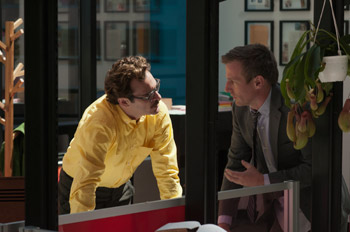
'Spike Jonze is interested in people and he's interested in the female point of view and what drives women emotionally, so you get characters like Amy and Catherine and Samantha," Amy Adams adds. 'He spent so much time and energy helping us understand these people and their connections with Theodore. I believe everyone will see something in these characters that reflects themselves and how they deal with relationships."
Rounding out the main cast is Olivia Wilde, who stars as a promising but mercurial blind date for Theodore in one remarkably vivid scene. On the surface, this date is the total package: gorgeous, smart, accomplished and flawlessly turned out, but on the inside it's another story. 'She's got it all, and yet she's damaged," says Olivia Wilde. 'She's fear-based; fears about her biological clock, fears about her own failures and where she's going. She has a similar void, like Theodore, and is desperate to fill it. With so much baggage, she makes an interesting contrast to Samantha, who has no baggage."
Olivia Wilde purposely did not meet Joaquin Phoenix prior to playing the scene. 'Spike Jonez wanted to keep us separate until that moment to maintain the nervous energy of a blind date, so it was kind of like jumping into the pool"which was thrilling, actually, and fun for an actor," she says.
The film's supporting cast also includes Chris Pratt as Theodore's easygoing office-mate, Paul, who invites Theodore and Samantha to join him and his own flesh-and-blood girlfriend on a double date and doesn't miss a beat when informed that Samantha is an OS; and Matt Letscher as Amy's opinionated husband, Charles.
Creating The Los Angeles Of Our Dreams
The story unfolds in an elegantly rendered and optimistically evolved Los Angeles"familiar enough to feel real but different enough to seem just slightly out of reach.
Says Spike Jonze, 'It's never really defined, when it is. We decided pretty early on that we weren't interested in predicting or presenting our view of what the future should look like. What was important was creating a future that felt right to this story."
What he envisioned was 'a kind of utopian environment where the weather is nice, the food is great, everything is beautiful and comfortable and made with quality materials, fabrics are soft and rich, and it's just a good, warm place to live. Technology has become more sophisticated and provides us with even more services to make our lives easier and better.
'Where everything is clean and colourful," he adds, 'seemed to me like an interesting setting for loneliness and disconnection, which is the sort of world we created for the movie and that's where we find Theodore when the story begins."
Producer Vincent Landay started pre-production early. 'While Spike Jonez was writing, we had a team of researchers around the world pulling visual references of modern architecture," he says. 'By the time he completed the first draft, we had compiled hundreds of images for him to review with K.K. Barrett, our production designer. This gave them a visual tool grounded in reality, which they could reference as they defined their vision of the future."
Helping to compose the look and mood, K.K. Barrett favoured a series of subtle adjustments toward what he calls 'a future that is around the corner rather than some distant time where the audience would marvel at all the changes. It often takes just a couple of altered conceits to shed a different light on society. We are in Los Angeles so I thought, -Take away the cars. What would it be like if there was no noticeable traffic? What if there was a subway to the beach? Get in at Hollywood and step out on the sand. Take a weekend trip to a cabin in the snow on a high-speed bullet train.'"
L.A. without cars? That required much creative license and images of a city in a different stage of development"a fair portion of what the filmmakers discovered in the relatively new Pudong District near Shanghai, where elevated walkways keep the pedestrian eye-line well above the distant hum of unseen vehicles.
'Much of Pudong was built in the last 12 years," says Spike Jonze, who examined other possible locations, including Dubai, Hong Kong, Beijing and cities in Germany and Singapore before finding what he was looking for. 'It has skyscrapers, the streets are straight and wide, the buildings are offset and everything is brand new. It was a magical combination of elements that worked, with lots of recent construction. And L.A. is all about -new.' It just seemed that if the city did develop in that way, this is what it would resemble."
Blending the Chinese and Southern California cityscapes involved some digital artistry. However, Spike Jonze states, 'There aren't a lot of visual effects in the film. We added buildings and removed signage from one skyline to another, and there's a holographic video game that Theodore plays in his living room, but overall it isn't an effects-heavy movie, especially for something set in the future."
Likewise, the filmmakers sought practical locations as much as possible. Says Landay, 'We make it a priority to create an environment actors can thrive in, and that includes the atmosphere on set and the set itself. Having a real apartment or office helps to ground the scene in reality and also better matches Spike's aesthetic than a studio set with green screen. To fully take advantage of this, we looked for interior locations that had lots of natural light. That created a greater challenge to schedule filming around the sun and moon, and for K.K. Barrett, who would have to transform these existing spaces and structures."
Los Angelinos will spot many authentic reference points, among them the landmark Santa Monica Pier where Theodore and Samantha enjoy a fun night out, and the stylish Pacific Design Center, which serves as the entrance to Theodore's apartment building.
Everywhere, art and comfort abound. Parks atop high-rises invite people to linger and enjoy the view. In keeping with the film's overall tone, K.K. Barrett says, even advertising is unobtrusive: 'It's mainly big, slow-motion images with a minimum of type or graphics, a soft sell for the viewer to be drawn in by the mystery of the image and not bludgeoned with hype."
On a more personal level, he furnished Theodore's office and home for ease and efficiency, with well-crafted simple items"especially in the devices that Theodore uses to communicate with Samantha. 'This is not a future of harshness but of bespoke details," he outlines. 'I like the way fountain pens and cigarette cases were designed in the 1940s, small leather address books and the feel of a Zippo lighter in your hand, things that are archaic in use but timeless in design. So, take the detail of those beautiful objects and apply them to something you use many times a day: your phone. Even in designing the tech end, I stayed away from new materials, instead framing the computer monitors as if they were photographs or art. These devices are meant to convey a link for human contact. They needed to be simple so the voice is what holds the viewer's attention."
Finally, he says, 'I always have a single buzzword for each film that informs a thread to the images. This time it was -red.' We sprinkled a lot of red around."
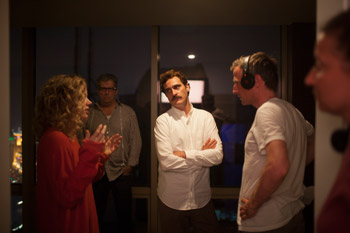 Red similarly echoes through the wardrobe selections provided by costume designer Casey Storm. 'We felt there would be lots of colour in the future and to embrace it. Theodore's office was bananas with colour, tinted glass and things like that," he says.
Red similarly echoes through the wardrobe selections provided by costume designer Casey Storm. 'We felt there would be lots of colour in the future and to embrace it. Theodore's office was bananas with colour, tinted glass and things like that," he says.
Like K.K. Barrett, Storm sought a design scheme that suggested the future without being futuristic. He and Spike Jonze reviewed a span of styles, from photos and from pieces Storm collected from thrift shops for early fittings. Acknowledging the cyclical nature of fashion, he says, 'We decided that going backwards made sense, incorporating a range of elements from different decades and styles and putting them together to create something new."
Outfitting the men in high-waisted trousers was a conscious nod towards the evolution of women's fashion of the past hundred years and applying it to menswear. 'Looking at the 1920s, 30s and 40s, and realising how women's styles in particular have often gone towards a higher waist, I liked the idea of pairing a high waist with a narrow tapered leg," Storm continues. 'We tried it on Spike Jonez and it looked good, then we tried it on Joaquin and it worked really well."
For Theodore, Storm chose a natural, comfortable look across a limited palette, stating, 'He wouldn't want his clothes to make him stand out. Plus, he's a creature of habit, so he tends to wear the same kinds of things. Joaquin Phoenix was in wardrobe pretty early in the process and it was very collaborative. There were times when he had an insight for his character I didn't have, and would suggest a shirt or a pair of pants I hadn't thought of."
As with the production design, it all came down to details and distinctions. 'For example," Storm cites, 'in the business world, men have worn suits and ties as far back as you can remember so we couldn't depart too drastically from that. Instead, we kept the suits but lost the ties or the lapels, or adjusted the proportions"nothing groundbreaking or calling too much attention to itself, but just enough to give the impression of being slightly off."
The Music
Music for the film was created by Grammy Award-winning band Arcade Fire, as well as their frequent collaborator Owen Pallett.
'Arcade Fire started writing the music as we were shooting, so I'd sometimes use it on set," Spike Jonze says. 'I'd send them stills and footage and they'd send us an amazing mass of material in batches, maybe 50 tracks, which we would refine, and then work on pieces we still needed, so the DNA of the music and the look and feel of the film feels very organic. The music is really beautiful and is very specific to the story."
Her
Release Date: January 16th, 2014
MORE
- Mission: Impossible Fallout
- Glenn Close The Wife
- Allison Chhorn Stanley's Mouth Interview
- Benicio Del Toro Sicario: Day of the Soldado
- Dame Judi Dench Tea With The Dames
- Sandra Bullock Ocean's 8
- Chris Pratt Jurassic World: Fallen Kingdom
- Claudia Sangiorgi Dalimore and Michelle Grace...
- Rachel McAdams Disobedience Interview
- Sebastián Lelio and Alessandro Nivola...
- Perri Cummings Trench Interview



